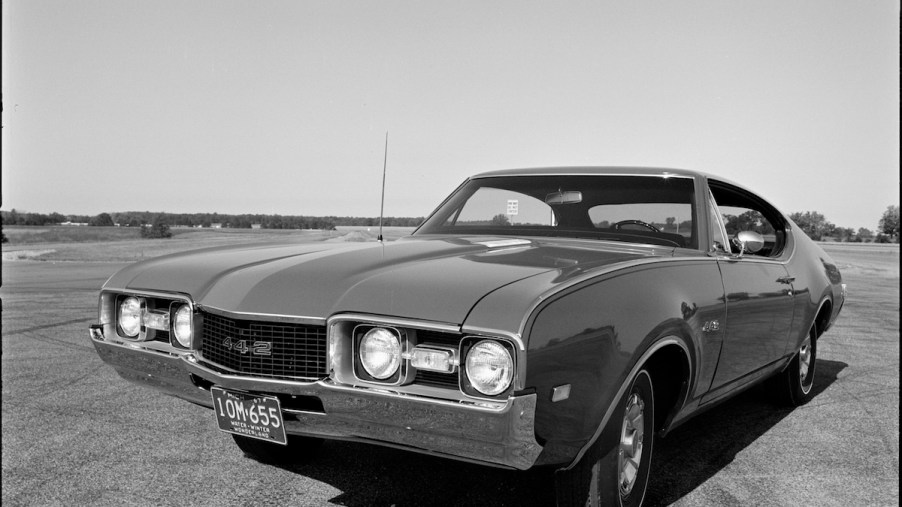
Why Is the 1971 Oldsmobile 442 So Sought After by Collectors?
Prior to 1968 and after 1971, the 442 badge was merely the moniker for an Oldsmobile Cutlass performance configuration option consisting of a four-barrel carburetor, a four-speed manual transmission, and factory dual exhaust.
By 1971 General Motors was determined to reduce vehicle emissions and produce cars that could run on regular-grade gasoline instead of premium fuels. For the most part this industry-wide change meant the end of the muscle car era as it was known.
The Oldsmobile 442
Introduced as a stand-alone model for the first time in 1968, the Oldsmobile 442 was equipped with a 400-cubic-inch V8 backed by a manual transmission that produced 350 hp. There was also an option for a W-30 engine upgrade that added cold-air-induction and a higher performance camshaft. The W-30 package raised the horsepower of stick shift equipped 442’s to 360 hp. Performance-minded buyers preferred the manual transmission because in 1968 the 400-cubic-inch engine with an automatic transmission was configured to produce 325 hp.
Car Life Magazine hosted a real-world test between an automatic 1968 Oldsmobile 442 and its performance enhanced stablemate sporting a manual transmission and W-30 upgrades, according to Motor 1. The W-30 equipped 442 covered a quarter-mile drag strip 1.83 seconds quicker and crossed the finish line going 11.1 mph faster.
In what would be essentially a last gasp of the performance muscle car era, Oldsmobile produced its last 442 in 1971, according to records. In the early 1970s automakers were facing increasing pressure from the US government to reduce emissions and improve fuel economy because of the Clean Air Act and the OPEC oil embargo inspired fuel crisis. Automobile insurance companies were also putting pressure on performance car enthusiasts by demanding ever-increasing insurance premiums from drivers of high-performance cars.
While 1971 saw cylinder compression ratios plummet from 10.5:1 to 8.5:1 to meet emissions standard and utilize unleaded fuel, Oldsmobile engineers were squeezing every bit of performance they could out of the current 455-cubic-inch engine equipped with a four-barrel Rochester carburetor. W-30 equipped 442s with manual transmissions still retained a more performance-oriented camshaft, an aluminum intake manifold, low restriction air cleaner, less restrictive dual exhaust, and an air induction hood to maintain 350 hp. General Motors only produced 110 Oldsmobile 442 with the W-30 option in 1971 though it is likely that many more were upgraded as a dealer-installed option.
The elusive 1971 Oldsmobile 442 L69
If an Oldsmobile enthusiast could go back in time to order their very own Oldsmobile 442 they would not be disappointed with the 1971 model, especially if they opted for the L69 package. Although the L69 configuration was available as early as 1966 on Oldsmobile Cutlasses in 442 trim, a 1971 Oldsmobile 442 L69 is a unicorn as it was the only year the option was available on 442s.
It was equipped with an upgraded suspension, a high-performance camshaft, and cold air induction via the W-30 option, but it was also blessed with three Rochester two-barrel carburetors instead of the single four-barrel that is so familiar. Okay, so technically the L69 package deviates from the 442 moniker since it changes the carburetor scheme, but it makes more horsepower, ten more in fact for a total of 360 hp.
How valuable is a 1971 Oldsmobile 442 L69?
A cursory search through the internet did not turn up and L69 equipped 442. There are, however, a couple of nice examples of 1971 Oldsmobile 442s sporting the W-30 package with asking prices in the $119,500 to $159,995 range, according to Autotrader. In 2016, Barrett Jackson sold a four-speed-manual-transmission-equipped, ebony black, convertible at auction in Scottsdale, Arizona for $185,000. There were 1,304 convertible 442s produced in 1971, and having the original engine along with period-correct transmission and drivetrain propelled the bidding.



